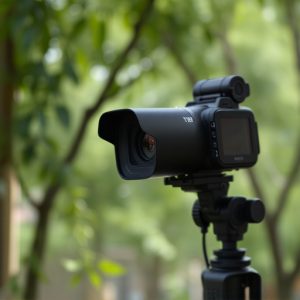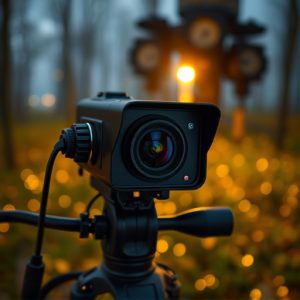Optimize Tiny Camera Placement for Home Surveillance Detection
Wireless surveillance systems using tiny cameras have revolutionized home security with their discre…….
Wireless surveillance systems using tiny cameras have revolutionized home security with their discreet, versatile, and powerful features like motion detection, night vision, and remote access via smartphones or computers. Setting up these cameras requires strategic placement to maximize signal strength and coverage, considering factors like walls, floors, ceiling heights, and structural obstructions. Discreet integration into decor ensures privacy while enhancing security without compromising aesthetics. Environmental factors like thick walls, metal frames, foliage, and weather impact signal quality, necessitating adjustments for optimal performance.
Uncover the secrets of wireless surveillance with our comprehensive guide on locating and optimizing tiny cameras for home monitoring. From understanding the basics of wireless equipment to advanced placement techniques, this article is your go-to resource. Learn how to choose the perfect spot for maximum signal strength and coverage while maintaining privacy. Discover environmental factors that can enhance detection accuracy, ensuring your home remains secure with these expert tips.
- Understanding Wireless Surveillance Equipment: A Brief Overview
- Choosing the Right Location for Optimal Signal Strength and Coverage
- Discreet Placement Techniques to Maintain Privacy
- Advanced Tips: Enhancing Detection Accuracy with Environmental Considerations
Understanding Wireless Surveillance Equipment: A Brief Overview
Wireless surveillance equipment, including tiny cameras for home monitoring, has revolutionized home security. These innovative devices offer discreet and versatile solutions for homeowners seeking peace of mind. Small in size but powerful in functionality, they can be easily hidden, providing a comprehensive view of your property. From motion-activated cameras to wireless door sensors, these tools enable you to monitor your home’s interior and exterior from anywhere, at any time, via your smartphone or computer.
Understanding how this technology works is key to effective location detection. Wireless surveillance systems transmit data using radio waves, allowing for remote access and real-time monitoring. The compact nature of tiny cameras means they can be strategically placed in hard-to-reach areas, ensuring a broader field of view and improved security. With advanced features like night vision, two-way audio, and motion detection, these devices offer a layered approach to home protection, giving you control over your safety and privacy.
Choosing the Right Location for Optimal Signal Strength and Coverage
When setting up wireless surveillance equipment, including tiny cameras for home monitoring, selecting the ideal location is key to achieving optimal signal strength and coverage. The placement of these devices should consider line-of-sight access to avoid obstructions that could impede the signal. Ensure the camera has a clear view of what it’s meant to monitor, whether it’s an entry point, a valuable asset, or a specific area within your home.
Factors like walls, floors, and ceiling heights can significantly affect signal quality. For instance, placing a wireless camera near a corner or along an exterior wall might provide better reception due to reduced interference from structural elements. Additionally, consider the range of the equipment; some tiny cameras may require a closer proximity to the router for reliable connectivity and clear video transmission.
Discreet Placement Techniques to Maintain Privacy
When setting up wireless surveillance equipment, especially tiny cameras for home monitoring, discreet placement is key to maintaining privacy. Mounting them in plain sight can deter potential intruders, but hiding them effectively ensures continuous monitoring while preserving peace of mind. Creative strategies like using fake rocks or incorporating them into everyday decor can help blend these devices seamlessly into your environment.
Consider installing them in areas that offer unobstructed lines of sight without loitering in obvious spots. For instance, placing tiny cameras on ceiling fans, behind picture frames, or under potted plants allows for unencumbered viewing while keeping the equipment out of plain view. This approach leverages the power of covert surveillance, enhancing security without sacrificing aesthetics.
Advanced Tips: Enhancing Detection Accuracy with Environmental Considerations
In the realm of wireless surveillance, enhancing detection accuracy goes beyond technical specifications. Environmental considerations play a crucial role in optimizing performance, especially with tiny cameras for home monitoring. The placement of these discreet devices should account for factors like interference from structural elements, such as thick walls or metal frames, which can affect signal strength and quality. Understanding these obstructions and their impact is vital for ensuring clear and consistent images.
Additionally, natural elements like trees, foliage, or even weather conditions can introduce variable challenges. For outdoor applications, consider the camera’s line of sight—clear obstacles allowing direct visibility significantly improve detection range and accuracy. Adjusting placement to avoid potential interference and taking advantage of unobstructed views will contribute to more precise and reliable location detection.
Wireless surveillance equipment, especially tiny cameras for home monitoring, offers unparalleled convenience and peace of mind. To maximize their potential, understanding the technology, strategically selecting locations for optimal signal strength, ensuring discreet placement, and considering environmental factors are key. By following these tips, you can enhance the accuracy of your location detection and create an effective security system tailored to your needs.


